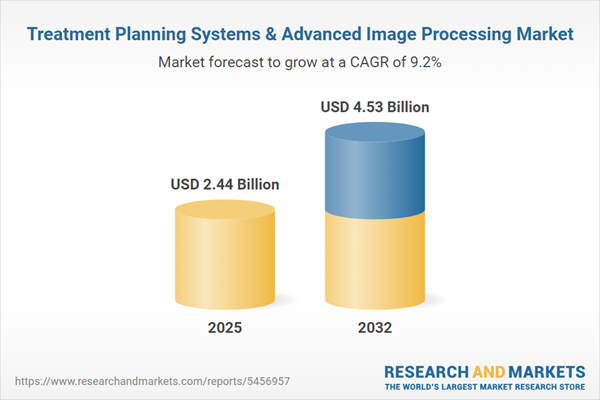Speak directly to the analyst to clarify any post sales queries you may have.
The Treatment Planning Systems & Advanced Image Processing Market is entering a phase of accelerated transformation as healthcare providers turn to data-driven tools to optimize precision medicine strategies. Industry stakeholders must understand the interplay of advanced technologies, regulatory conditions, and shifting operational requirements to make informed, future-proof decisions.
Market Snapshot: Treatment Planning Systems & Advanced Image Processing
The global market for treatment planning systems and advanced image processing is experiencing consistent expansion, propelled by escalating demand for integrated platforms that boost precision and efficiency in clinical workflows. Growth is shaped by rapid adoption of cloud, artificial intelligence, machine learning, and enhanced imaging modalities across oncological and radiological applications. An increased emphasis on system interoperability and compliance with evolving regulatory standards also plays a critical role in expanding market reach and fostering collaboration among multidisciplinary teams.
Scope & Segmentation
This report provides a detailed analysis of the market, segmented by key categories, regions, and technological capabilities:
- Component: Hardware, Services, Software
- Application: Contouring, Dose Calculation, Registration, Visualization
- Modality: Imaging (Computed Tomography, Magnetic Resonance Imaging, Positron Emission Tomography), Radiotherapy (Brachytherapy—High Dose Rate, Low Dose Rate; External Beam—Intensity Modulated Radiotherapy, Stereotactic Radiotherapy, Volumetric Modulated Arc Therapy), Proton Therapy (Passive Scattering, Pencil Beam Scanning)
- Delivery Mode: Cloud, On Premise
- End User: Clinics, Hospitals, Research Institutes
- Geographical Regions: Americas (United States, Canada, Mexico, Brazil, Argentina, Chile, Colombia, Peru), Europe (United Kingdom, Germany, France, Russia, Italy, Spain, Netherlands, Sweden, Poland, Switzerland), Middle East (United Arab Emirates, Saudi Arabia, Qatar, Turkey, Israel), Africa (South Africa, Nigeria, Egypt, Kenya), Asia-Pacific (China, India, Japan, Australia, South Korea, Indonesia, Thailand, Malaysia, Singapore, Taiwan)
- Key Companies: Siemens Healthineers AG, Elekta AB (publ), Accuray Incorporated, RaySearch Laboratories AB (publ), Koninklijke Philips N.V., General Electric Company, Brainlab AG, MIM Software Inc., ViewRay Inc., Mirada Medical Ltd.
Key Takeaways for Senior Decision-Makers
- Interconnected treatment planning environments are redefining discipline boundaries, enabling integrated workflows among oncologists, physicists, and radiologists.
- Automation and artificial intelligence increasingly streamline core processes, freeing clinical teams for personalized patient strategies and reducing potential for manual errors.
- Regional adaptation is vital; while North America drives cloud adoption, Europe emphasizes adaptive radiotherapy, Asia-Pacific accelerates infrastructure investments, and emerging regions prioritize foundational capabilities.
- Compliance is now fundamental; updated regulations impact procurement and manufacturing, creating interdependencies between vendor roadmaps and international policy shifts.
- Strategic partnerships—such as those between healthcare providers, technology vendors, and research institutions—drive technology co-development and help fast-track solution implementation.
- Bundled service offerings and cloud delivery modes reshape customer engagement, with subscription and remote support models gaining traction among providers seeking cost predictability.
Tariff Impact and Adaptive Strategies
Changes in United States tariff structures have introduced new complexities for global and domestic market participants. Heightened acquisition costs for pivotal hardware components, such as imaging detectors and accelerator modules, are prompting a shift toward localized manufacturing and regional supply chain refinement. Providers are exploring cloud-based platforms and subscription models to help mitigate fluctuating expenses tied to tariffs, while adjusting maintenance agreements to align with the evolving cost landscape. These strategic shifts contribute to a more resilient and diversified market structure.
Methodology & Data Sources
The findings in this analysis stem from a rigorous combination of primary and secondary research methods. Direct interviews with leading clinicians, technologists, and regulatory specialists provided qualitative insights, while a review of peer-reviewed publications, technical white papers, and patent filings informed technology trends. Strict data triangulation and quality assurance frameworks were applied to validate accuracy.
Why This Report Matters
- Delivers in-depth segmentation analysis for actionable investment and technology strategies.
- Enables senior leaders to benchmark organizational positioning within a rapidly evolving competitive set.
- Supports data-driven decision-making by highlighting regulatory priorities, partnerships, and market adaptation strategies.
Conclusion
This report equips healthcare decision-makers with fact-driven insights to navigate emerging technologies and regulatory challenges. By aligning organizational strategy with evolving market dynamics, leaders can seize opportunities, strengthen partnerships, and enhance patient care outcomes.
Additional Product Information:
- Purchase of this report includes 1 year online access with quarterly updates.
- This report can be updated on request. Please contact our Customer Experience team using the Ask a Question widget on our website.
Table of Contents
3. Executive Summary
4. Market Overview
7. Cumulative Impact of Artificial Intelligence 2025
Companies Mentioned
The companies profiled in this Treatment Planning Systems & Advanced Image Processing market report include:- Siemens Healthineers AG
- Elekta AB (publ)
- Accuray Incorporated
- RaySearch Laboratories AB (publ)
- Koninklijke Philips N.V.
- General Electric Company
- Brainlab AG
- MIM Software Inc.
- ViewRay Inc.
- Mirada Medical Ltd.
Table Information
| Report Attribute | Details |
|---|---|
| No. of Pages | 183 |
| Published | October 2025 |
| Forecast Period | 2025 - 2032 |
| Estimated Market Value ( USD | $ 2.44 Billion |
| Forecasted Market Value ( USD | $ 4.53 Billion |
| Compound Annual Growth Rate | 9.2% |
| Regions Covered | Global |
| No. of Companies Mentioned | 10 |









